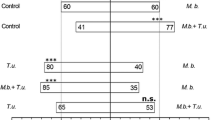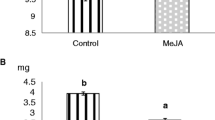Abstract
Lima bean plants respond to feeding damage of two-spotted spider mites (Tetranychus urticae) with the emission of a complex blend of volatiles that are products of several different biosynthetic pathways. These volatiles attract the carnivorous mite Phytoseiulus persimilis, a specialist predator of the spider mites that exterminates entire prey populations, and thus the volatiles contribute indirectly to plant defense. The volatile blend constitutes information to the carnivores, and blend composition is an important factor in this. Jasmonic acid (JA) is involved in the signal transduction of this induced defense. Application of JA through the petiole of Lima bean plants induces a volatile blend that is similar, but not identical, to that emitted by spider mite-infested plants. The induced volatiles originate from the lipoxygenase pathway, the shikimic acid pathway, and the isoprenoid pathway. Among the induced bean plant volatiles are nitriles and oximes. Of a total of 61 components, 10 are emitted at significantly different rates. Among these are the terpene (E)-4,8-dimethyl-1,3,7-nonatriene and the phenolic methyl salicylate, two compounds that are known to attract P. persimilis. A crucial test for comparing the effect of spider mite damage and JA application on volatile induction is the response of P. persimilis. The carnivore is attracted by volatiles from JA-treated plants. Moreover, even treatment of Lima bean plants with methyl jasmonate vapor made the plants attractive to the carnivorous mites. However, the predators prefer the volatiles from spider-mite-infested Lima bean plants over those from JA-treated plants. Thus, chemical as well as behavioral analyses demonstrate that spider mite damage and JA treatment have similar, although not identical, effects on volatile induction in Lima bean plants.
Similar content being viewed by others
REFERENCES
Alborn, H. T., Turlings, T. C. J., Jones, T. H., Steinhagen, G., Loughrin, J. H., and Tumlinson, J. H. 1997. An elicitor of plant volatiles from beet armyworm oral secretion. Science 276:945-949.
Avdiushko, S., Croft, K. P. C., Brown, G. C., Jackson, D. M., Hamilton-Kemp, T. R., and Hildebrand, D. 1995. Effect of volatile methyl jasmonate on the oxylipin pathway in tobacco, cucumber, and arabidopsis. Plant Physiol. 109:1227-1230.
Baldwin, I. T., Zang, Z.-P., Diab, N., Ohnmeiss, T. E., McCloud, E. S., Lynds, G. Y., and Schmelz, E. A. 1997. Quantification, correlations and manipulations of wound-induced changes in jasmonic acid and nicotine in Nicotiana sylvestris. Planta 201:397-404.
Bell, E., and Mullet, J., 1991. Lipoxygenase gene expression is modulated in plants by water deficit, wounding, and methyl jasmonate. Mol. Gen. Genet. 230:456-462.
Boland, W., Hopke, J., Donath, J., Nueske, J., and Bublitz, F. 1995. Jasmonic acid and coronatin induce odor production in plants. Angew. Chem. Int. Ed. Engl. 34:1600-1602.
Bouwmeester, H. J., Verstappen, F., Posthumus, M. A., and Dicke, M. 1999. Spider-mite induced (3S)-(E)-nerolidol synthase in cucumber and Lima bean. The first dedicated step in acyclic C11-homoterpene biosynthesis. Plant Physiol. In press.
Bowles, D. J., Gilmartin, P. M., Knox, J. P., and Lunt, G. G. (eds.). 1994. Molecular Botany: Signals and the Environment. Portland Press, London, 288 pp.
Bruin, J., Sabelis, M. W., and Dicke, M. 1995. Do plants tap SOS signals from their infested neighbours? Trends Ecol. Evol. 10:167-170.
Dicke, M. 1999. Evolution of induced indirect defence of plants, pp. 483-520, in R. Tollrian and C. D. Harvell (eds.). Evolution of Inducible Defenses. Princeton University Press, Princeton, New Jersey.
Dicke, M., Beek, T. A. van, Posthumus, M. A., Ben Dom, N., Bokhoven, H. van, and Groot, A. E. de. 1990. Isolation and identification of volatile kairomone that affects acarine predator-prey interactions. Involvement of host plant in its production. J. Chem. Ecol. 16:381-396.
Dicke, M., Sabelis, M. W., Bogaers, R. J. F., Alers, M., and Halder, I. van. 1991. Kairomone perception by a predatory mite: Behavioral analysis of chemoreceptor-carrying extremities. Proc. Exp. Appl. Entomol. 2:179-184.
Doares, S. H., Narvaez-Vasquez, J., Conconi, A., and Ryan, C. A. 1995. Salicylic acid inhibits synthesis of proteinase inhibitors in tomato leaves induced by systemin and jasmonic acid. Plant Physiol. 108:1741-1746.
Farmer, E. E., and Ryan, C. A. 1990. Interplant communication: Airborne methyl jasmonate induces synthesis of proteinase inhibitors in plant leaves. Proc. Natl. Acad. Sci. U.S.A. 87:7713-7716.
Farmer, E. E., and Ryan, C. A. 1992. Octadecanoid precursors of jasmonic acid activate the synthesis of wound-inducible proteinase inhibitors. Plant Cell 4:129-134.
Farmer, E. E., Weber, H., and Vollenweider, S. 1998. Fatty acid signaling in Arabidopsis. Planta 206:167-174.
Gundlach, H., Muller, M. J., Kutchan, T. M., and Zenk, M. H. 1992. Jasmonic acid is a signal transducer in elicitor-induced plant cell cultures. Proc. Natl. Acad. Sci. U.S.A. 89:2389-2393.
Hopke, J., Donath, J., Blechert, S., and Boland, W. 1994. Herbivore-induced volatiles: The emission of acyclic homoterpenes from leaves of Phaseolus lunatus and Zea mays can be triggered by a β-glucosidase and jasmonic acid. FEBS Lett. 352:146-150.
Jagers op Akkerhuis, G., Sabelis, M. W., and Tjallingh, W. F. 1985. Ultrastructure of chemoreceptors on the pepidalps and first tarsi of Phytoseiulus persimilis. Exp. Appl. Acarol. 1:235-251.
Kaiser, R. 1993. On the scent of orchids, pp. 240-268, in R. Teranishi, R. G. Buttery, and H. Sugisawa (eds.). Bioactive Volatile Compounds from Plants. ACS Symposium Series 525, Washington, D.C.
Karban, R., and Baldwin, I. T. 1997. Induced responses to herbivory. University of Chicago Press, Chicago, 300 pp.
Krips, O. E., Willems, P. E. L., Gols, R., Posthumus, M. A., and Dicke, M. 1999. The response of Phytoseiulus persimilis to spider-mite induced volatiles from gerbera: influence of starvation and experience. J. Chem. Ecol. In press.
Laat de, A. M. M., and Van Loon, L. C. 1981. Regulation of ethylene biosynthesis in virus-infected tobacco leaves. I. Determination of the role of methionine as the precursor of ethylene. Plant Physiol. 68:256-260.
Laudert, D., and Weiler, E. W. 1998. Allene oxide synthase: A major control point in Arabidopsis thaliana octadecanoid signalling. Plant J. 15:675-684.
Lois, R., Dietrich, A., Hahlbrock, K., and Schulz, W. 1989. A phenylalanine ammonia-lyase gene from parsley: Structure, regulation and identification of elicitor and light responsive cisacting elements. EMBO J. 8:1641-1648.
Malamy, J., Sanchez-Casas, P., Hennig, J., Guo, A. L., and Klessig, D. F. 1996. Dissection of the salicylic acid signaling pathway in tobacco. Mol. Plant-Microbe Interactions 9:474-482.
Mattiacci, L., Dicke, M., and Posthumus, M. A. 1995. Beta-glucosidase: An elicitor of herbivore-induced plant odor that attracts host-searching parasitic wasps. Proc. Natl. Acad. Sci. U.S.A. 92:2036-2040.
Metraux, J. P., Signer, H., Ryals, J., Ward, E., Wyss-Benz, M., Gaudin, J., Raschdorf, K., Schmid, E., Blum, W., and Inverardi, B. 1990. Increase in salicylic acid at the onset of systemic acquired resistance in cucumber. Science 250:1004-1006.
O'Donnell, P. J., Calvert, C., Atzorn, R., Wasternack, C., Leyser, H. M. O., and Bowles, D. J. 1996. Ethylene as a signal mediating the wound response of tomato plants. Science 274:1914-1917.
Pena-Cortes, H., Albrecht, T., Prat, S., Weiler, E. W., and Willmitzer, L. 1993. Aspirin prevents wound-induced gene expression in tomato leaves by blocking jasmonic acid biosynthesis. Planta 191:123-128.
Powell, W., Pennacchio, F., Poppy, G. M., and Tremblay, E. 1998. Strategies involved in the location of hosts by the parasitoid Aphidius ervi Haliday. Biol. Control 11:104-112.
Ryals, J., Lawton, K. A., Delaney, T. P., Friedrich, L., Kessmann, H., Neuenschwander, U., Uknes, S., Vernooij, B., and Weymann, K. 1995. Signal transduction in systemic acquired resistance. Proc. Natl. Acad. Sci. U.S.A. 92:4202-4205.
Sabelis, M. W., and van de Baan, H. E. 1983. Location of distant spider mite colonies by phytoseiid predators: Demonstration of specific kairomones emitted by Tetranychus urticae and Panonychus ulmi. Entomol. Exp. Appl. 33:303-314.
Sabelis, M. W., and Dicke, M. 1985. Long-range dispersal and searching behavior, pp. 141-160, in W. Helle and M. W. Sabelis (eds.). Spider Mites, Their Biology, Natural Enemies and Control. World Crop Pests 1b. Elsevier, Amsterdam.
SchÜtz, S. Weissbecker B., Klein, A., and Hummel, H. E. 1997. Host plant selection of the colorado potato beetle as influenced by damage induced volatiles of the potato plant. Naturwissenschaften 84:212-217.
Shulaev, V., Silverman, P., and Raskin, I. 1997. Airborne signalling by methyl salicylate in plant pathogen resistance. Nature 385:718-721.
Takabayashi, J., and Dicke, M. 1992. Response of predatory mites with different rearing histories to volatiles of uninfested plants. Entomol. Exp. Appl. 64:187-193.
Takabayashi, J., Dicke, M., and Posthumus, M. A. 1991. Variation in composition of predator-attracting allelochemicals emitted by herbivore-infested plants: Relative influence of plant and herbivore. Chemoecology 2:1-6.
Turlings, T. C. J., Tumlinson, J. H., and Lewis, W. J. 1990. Exploitation of herbivore-induced plant odors by host-seeking parasitic wasps. Science 250:1251-1253.
Turlings, T. C. J., WÄckers, F. L., Vet, L. E. M., Lewis, W. J., and Tumlinson, J. H. 1993a. Learning of host-finding cues by hymenopterous parasitoids, pp. 51-78, in D. R. Papaj and A. C. Lewis (eds.). Insect Learning. Chapman & Hall, New York.
Turlings, T. C. J., McCall, P., Alborn, H. T., and Tumlinson, J. H. 1993b. An elicitor in caterpillar oral secretions that induces corn seedlings to emit chemical signals attractive to parasitic wasps. J. Chem. Ecol. 19:411-425.
Vet, L. E. M., Jong, A. G. de, Franchi, E., and Papaj, D. R. 1998. The effect of complete versus incomplete information on odour discrimination in a parasitic wasp. Anim. Behav. 55:55:1271-1279.
Wasternack, C., and Parthier, B. 1997. Jasmonate-signalled plant gene expression. Trends Plant Sci. 2:302-307.
Weissbecker, B., SchÜtz, S., Klein, A., and Hummel, H. E. 1997. Analysis of volatiles emitted by potato plants by means of a Colorado potato beetle electroantennographic detector. Talanta 44:2217-2242.
Author information
Authors and Affiliations
Rights and permissions
About this article
Cite this article
Dicke, M., Gols, R., Ludeking, D. et al. Jasmonic Acid and Herbivory Differentially Induce Carnivore-Attracting Plant Volatiles in Lima Bean Plants. J Chem Ecol 25, 1907–1922 (1999). https://doi.org/10.1023/A:1020942102181
Issue Date:
DOI: https://doi.org/10.1023/A:1020942102181




